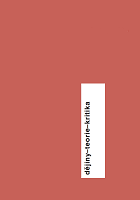"Mediality" Some Fundamental Questions on the Theory and History of Media
"Mediality" Some Fundamental Questions on the Theory and History of Media
Author(s): Richard MüllerSubject(s): Media studies, Theory of Communication, Theory of Literature
Published by: Univerzita Karlova v Praze - Fakulta humanitních studií
Keywords: Mediality; literature; Friedrich Kittler; Niklas Luhmann; Lars Elleström;
Summary/Abstract: The article looks at basic questions concerning mediality, which it defines as a common attribute of techno anthropological means of representation and communication, as developed and developing through mutual interaction, such as to give rise to a particular environment in which certain forms (of sense) can be distinguished. Among the basic questions of mediality and media are thus also those of whether and to what extent media conceptualize their own history and development. The study presents – primarily from the perspective of the theory and history of literature and art – a critical overview of media theory, starting with the ideas of Friedrich Kittler. It compares these with certain aspects of Marshall McLuhan’s thought, pointing out a conflict between the concept of an escalating development of media towards a closed cybernetic loop, and the concept of media as an evolutionary extension of human senses. The rhetorical and stylistic aspects of Kittler’s perspective are interpreted through Bürger’s (and Benjamin’s) thesis of the melancholic dimension of modernism. The basic principles of Niklas Luhmann’s theory of systems are analysed as a stimulus for thinking about mediality, together with his concept of a system of art as a functionally differentiated social system, historically established with the dawning of the modern age. We also pay attention to the intermedial research carried out by Lars Elleström and his description of a system of modalities, which sets up a new frame for approaching media. Elleström’s model enables us to reflect on media from many varied perspectives (such as mass media studies, new media, film media, film science, art history and theory, literary criticism, etc.), yet does not cover sources of media dynamics; these may relate to a certain gap or difference that enters the relationship between consciousness and communication, technology and the body, technology and the senses, and seems toset in motion the development of these constantly changing techno-anthropological tools.
Journal: Dějiny - Teorie - Kritika
- Issue Year: 2018
- Issue No: 01
- Page Range: 49-67
- Page Count: 19
- Language: English

